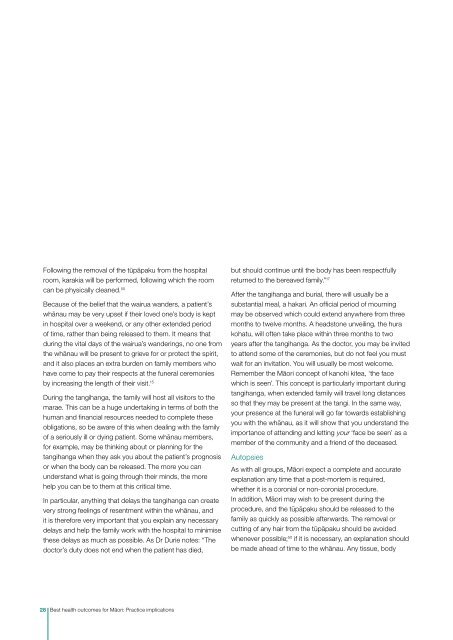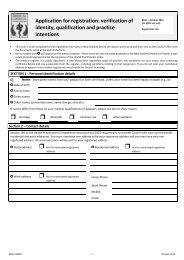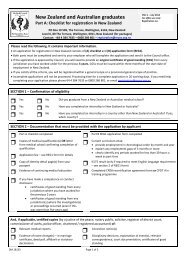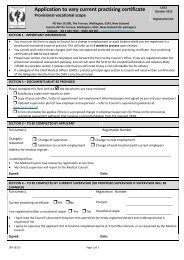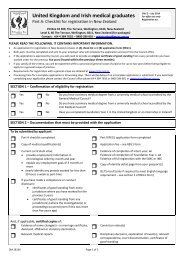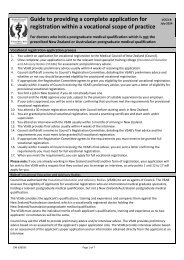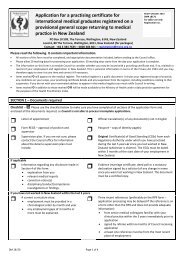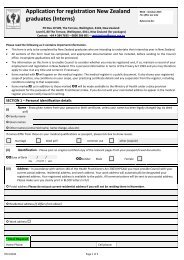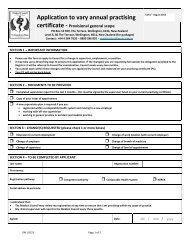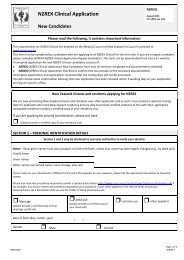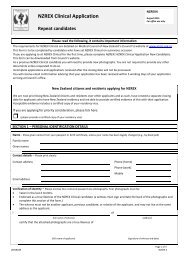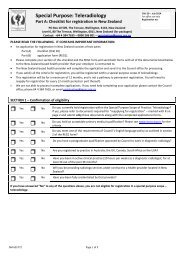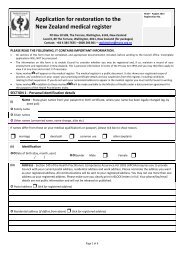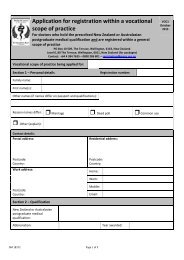Best health outcomes for Maori - Medical Council of New Zealand
Best health outcomes for Maori - Medical Council of New Zealand
Best health outcomes for Maori - Medical Council of New Zealand
You also want an ePaper? Increase the reach of your titles
YUMPU automatically turns print PDFs into web optimized ePapers that Google loves.
Following the removal <strong>of</strong> the tüpäpaku from the hospital<br />
room, karakia will be per<strong>for</strong>med, following which the room<br />
can be physically cleaned. 50<br />
Because <strong>of</strong> the belief that the wairua wanders, a patient’s<br />
whänau may be very upset if their loved one’s body is kept<br />
in hospital over a weekend, or any other extended period<br />
<strong>of</strong> time, rather than being released to them. It means that<br />
during the vital days <strong>of</strong> the wairua’s wanderings, no one from<br />
the whänau will be present to grieve <strong>for</strong> or protect the spirit,<br />
and it also places an extra burden on family members who<br />
have come to pay their respects at the funeral ceremonies<br />
by increasing the length <strong>of</strong> their visit. 15<br />
During the tangihanga, the family will host all visitors to the<br />
marae. This can be a huge undertaking in terms <strong>of</strong> both the<br />
human and financial resources needed to complete these<br />
obligations, so be aware <strong>of</strong> this when dealing with the family<br />
<strong>of</strong> a seriously ill or dying patient. Some whänau members,<br />
<strong>for</strong> example, may be thinking about or planning <strong>for</strong> the<br />
tangihanga when they ask you about the patient’s prognosis<br />
or when the body can be released. The more you can<br />
understand what is going through their minds, the more<br />
help you can be to them at this critical time.<br />
In particular, anything that delays the tangihanga can create<br />
very strong feelings <strong>of</strong> resentment within the whänau, and<br />
it is there<strong>for</strong>e very important that you explain any necessary<br />
delays and help the family work with the hospital to minimise<br />
these delays as much as possible. As Dr Durie notes: “The<br />
doctor’s duty does not end when the patient has died,<br />
2 <strong>Best</strong> <strong>health</strong> <strong>outcomes</strong> <strong>for</strong> Mäori: Practice implications<br />
but should continue until the body has been respectfully<br />
returned to the bereaved family.” 17<br />
After the tangihanga and burial, there will usually be a<br />
substantial meal, a hakari. An <strong>of</strong>ficial period <strong>of</strong> mourning<br />
may be observed which could extend anywhere from three<br />
months to twelve months. A headstone unveiling, the hura<br />
kohatu, will <strong>of</strong>ten take place within three months to two<br />
years after the tangihanga. As the doctor, you may be invited<br />
to attend some <strong>of</strong> the ceremonies, but do not feel you must<br />
wait <strong>for</strong> an invitation. You will usually be most welcome.<br />
Remember the Mäori concept <strong>of</strong> kanohi kitea, ‘the face<br />
which is seen’. This concept is particularly important during<br />
tangihanga, when extended family will travel long distances<br />
so that they may be present at the tangi. In the same way,<br />
your presence at the funeral will go far towards establishing<br />
you with the whänau, as it will show that you understand the<br />
importance <strong>of</strong> attending and letting your ‘face be seen’ as a<br />
member <strong>of</strong> the community and a friend <strong>of</strong> the deceased.<br />
Autopsies<br />
As with all groups, Mäori expect a complete and accurate<br />
explanation any time that a post-mortem is required,<br />
whether it is a coronial or non-coronial procedure.<br />
In addition, Mäori may wish to be present during the<br />
procedure, and the tüpäpaku should be released to the<br />
family as quickly as possible afterwards. The removal or<br />
cutting <strong>of</strong> any hair from the tüpäpaku should be avoided<br />
whenever possible; 50 if it is necessary, an explanation should<br />
be made ahead <strong>of</strong> time to the whänau. Any tissue, body


